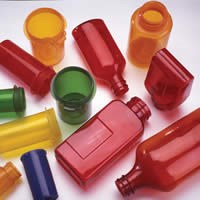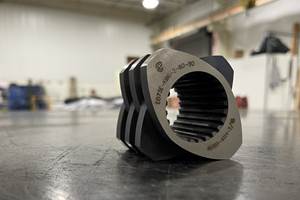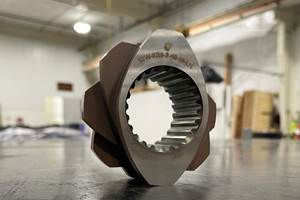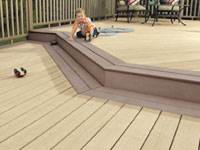More New Colorants & Additives at NPE 2009
In July we reported on new colorants and additives to be shown at NPE in Chicago, based on information available before the show (see Learn More box). But the miles of aisles at McCormick Place held still more newsworthy product introductions.
In July we reported on new colorants and additives to be shown at NPE in Chicago, based on information available before the show (see Learn More box). But the miles of aisles at McCormick Place held still more newsworthy product introductions. Included in this follow-up report are additives that are geared to lightweighting but also offer improvements in strength and aesthetics, as well as specialty pigments ranging from improved whites to “heat-management” pigments, and those that glow in the dark. Notable too, are new nano additives, UV stabilizers for PET packaging, and a cycle-time reduction additive for polyolefins.
FOCUS ON LIGHTWEIGHTING
Additives can help reduce weight through foaming or by adding stiffness and strength with lower loadings or lower density. The first in a family of unusual mineral fillers for polypropylene and other polyolefins in molded automotive, appliance, and consumer goods was launched by Milliken Chemical. It boasts weight savings compared with traditional mineral-filled systems along with an outstanding balance of stiffness and toughness. Part surface finish is said to be comparable to talc-filled systems.
Hyperform HPR-803 is an inorganic, fibrous mineral. It reportedly can replace fillers such as talc with lower loadings (10% vs. 25 to 30%) and thereby reduce part weight by up to 15%. It has been also shown to give greater stiffness than do higher loadings of talc or other mineral fillers, and also to provide higher HDT than is obtained with high levels of talc.
As a replacement for chopped glass, HPR-803 boasts improved surface finish, allowing processors to expand application for PP and other polyolefins beyond non-appearance structural automotive and appliance parts to include exterior components such as bumpers and door panels.
Meanwhile, Potters Industries has developed new hollow microspheres that offer higher crush strength in thermoplastics and thermosets. Among these are Sphericel 34P30 (0.34 g/cc) and 25P54 (0.25 g/cc) for use in nylon, PBT, and PP. Potters has also expanded its solid glass microsphere portfolio to include grades smaller than the standard 10-micron range. There is also a new microsphere product with a proprietary ceramic composition that is said to have much higher scratch-and-abrasion resistance and very good whiteness.
Gateway Composites announced new chopped carbon fibers with higher strength than previous grades for use in high-temperature plastics such as PEEK and PEI (SABIC’s Ultem). They come in 3-, 6-, and 12mm lengths.
Bergen International has a whole new series of blowing agents that mark its entry into the rigid PVC construction market, such as boards. Included are endo/exothermic blends Exo P331 (powder) and Exo 408 (pellet version). They are said to result in fine cell structures and improved productivity with reduced scrap due their improved processing properties.
(As reported in July, Reedy International and Americhem also brought out new foaming additives.)
PIGMENTS WITH FLAIR
Several new developments in pigment technology were unveiled by BASF. A new generation of titanium dioxide-coated mica pearlescent pigment reportedly yields a “whiter” white than previous mica-based pearlescents. Glacier Frost White EH682 (9S130D) boasts high luster and brightness and has a bluish reflection color to create white to black shades without the yellowish appearance of conventional pearlescents.
Also new are two additions to BASF’s Mark-it laser-markable additives—one for PMMA and one for PET blow molding.
BASF also has been developing heat-management pigments that are jet black but transparent (non-absorbing) to near infrared (NIR). They are organic perylene blacks unlike the carbon blacks typically used for heat management. Among these are Lumogen FK 4280 and 4281 for use in PVC and polyolefin construction applications.
Another example is new Lumogen IR 1050 PC, which has no visible color but allows NIR to be absorbed and then re-emitted by polycarbonate sunroofs. This product is a combination of an organic-inorganic nanopigment and a UV absorber.
DayGlo introduced NGX-19, the latest addition to its NightGlo glow-in-the-dark pigments. This nontoxic, photoluminiscent pigment is a mixed-metal oxide that is said to phosphoresce up to 10 times longer than standard zinc sulfide pigments. It boasts a strong, blue afterglow for up to 15 hr after charging and is available in fluorescent magenta (GPF22) and fluorescent yellow (GPF34). In free-flowing prill form, the pigment has heat stability up to 550 F.
NANO ADDITIVES & MORE
NanoBioMatters, a Spanish firm that now has a U.S. office, introduced two new nanoclay additives at NPE. NanoBioTer is designed specifically to improve barriers to oxygen, nitrogen, carbon dioxide, flavor, and aroma in food packaging. It meets FDA and EU food-contact specs. Only 4% of this surface-treated nanoclay in a 5-micron EVOH layer is said to double barrier performance, even at high humidity.
The company also introduced NanoBioTer+, a silver-functionalized nanoclay as a safe, long-lasting antimicrobial.
As reported in July, Nanophase Technologies is a supplier of nano-scale zinc oxide, antimony tin oxide, aluminum oxide, and bismuth oxide for use in blocking UV or infrared light, providing x-ray visibility, or adding scratch resistance. Relatively new to plastics, Nanophase offers its products as pellet or powder masterbatches containing 30% to 40% nano additive in PP, LLDPE, or PC. These products maintain transparency but contribute some haze.
Meanwhile, Americhem has new customizable high-performance UV stabilizer concentrates for PET flexible and rigid packaging. Called nDuramax, they are designed to extend shelf life of product contents and enhance package color consistency. Initial grades are geared to pharmaceutical and specialty beverage bottles.
Also new from Americhem is a proprietary cycle-time reduction additive that is said to improve both productivity and overall product quality. New xCelmax raises the crystallization temperature of a PP and HDPE so that products such as pails, bottles, closures, door panels, and thermoformed containers can be ejected sooner. At the same time, xCelmax reportedly reduces the potential for defects due to warping. It comes in pellets and beads.
Related Content
What to Know About Your Materials When Choosing a Feeder
Feeder performance is crucial to operating extrusion and compounding lines. And consistent, reliable feeding depends in large part on selecting a feeder compatible with the materials and additives you intend to process. Follow these tips to analyze your feeder requirements.
Read MoreHow to Configure Your Twin-Screw Extruder for Mixing: Part 5
Understand the differences between distributive and dispersive mixing, and how you can promote one or the other in your screw design.
Read MoreHow to Configure Your Twin-Screw Extruder: Part 3
The melting mechanism in a twin-screw extruder is quite different from that of a single screw. Design of the melting section affects how the material is melted, as well as melt temperature and quality.
Read MoreGreen’s the Theme in Extrusion/Compounding
The drive toward circular economy is requiring processors to make more use of PCR. Machine builders at K—across all extrusion processes—will be highlighting innovations to help them do just that.
Read MoreRead Next
NPE News in Additives
Colorants were the most numerous class of additives making news at the huge triennial plastics exhibition last month in Chicago. Some of the new colorants were aimed at specialized applications, from natural-fiber composites to laser marking, while others were for aesthetic special effects, such as color shifts and diamond-like sparkle.
Read MoreFor PLASTICS' CEO Seaholm, NPE to Shine Light on Sustainability Successes
With advocacy, communication and sustainability as three main pillars, Seaholm leads a trade association to NPE that ‘is more active today than we have ever been.’
Read MoreMaking the Circular Economy a Reality
Driven by brand owner demands and new worldwide legislation, the entire supply chain is working toward the shift to circularity, with some evidence the circular economy has already begun.
Read More




























